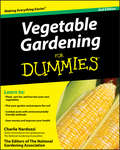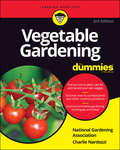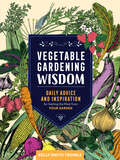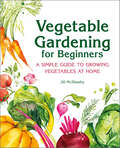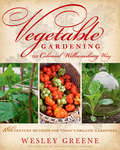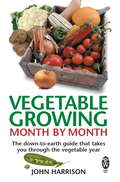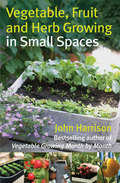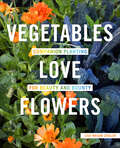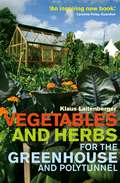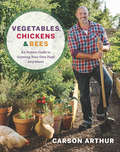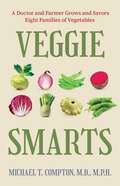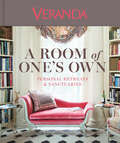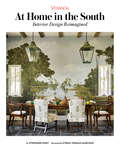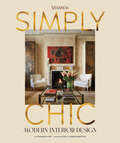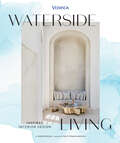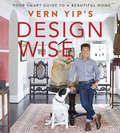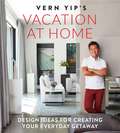- Table View
- List View
Vegetable Gardening For Dummies
by Charlie NardozziA hands-on guide to the ins and outs of raising and using vegetablesWant to grow your own vegetables? You can do it the fun and easy way with this practical guide. From selecting the right spot to preparing the soil to harvesting, Vegetable Gardening For Dummies, 2nd Edition shows you how to successfully raise vegetables regardless of the size of your plot or your dietary needs.You'll discover how to plot your garden and get the soil in tip-top shape; select the types of vegetables you want to grow; plant the seeds properly; and care for them as they grow. You'll also know the right time to pick your vegetables and the best ways to enjoy them. Plus, you'll get tips on preserving foods grown at home.Expert advice on planting, caring for, harvesting, and enjoying the fruits of your own vegetable gardenFeatures environmentally friendly ways to combat pests in your gardenCharlie Nardozzi is senior horticulturist and spokesperson for the National Gardening Association; he's also been the gardening expert on such programs as HGTV's Today at Home and Way to Grow and the Discovery Channel's Home MattersWhether you have a green thumb or you've never grown a plant before, Vegetable Gardening For Dummies, 2nd Edition has all the information you need to create a healthy garden.
Vegetable Gardening For Dummies (For Dummies Ser.)
by Charlie Nardozzi National Gardening AssociationVegetables from your own farm to your own table We all love good food, and the fresher it is, the better! And what could be fresher than farm-to-table terms than vegetables you've grown at home? The new edition of Vegetable Gardening For Dummies puts you in touch with your roots in a thousands of years old farming tradition by demonstrating how easy it is to grow your own. And there's no need to buy a farm: all you need to become a successful cultivator of the land is this book and a small plot of soil in the yard, or a container set aside for some tasty natural edibles. Add water and some care, love, and attention—et voila! In a friendly, come-relax-in-my-garden style Charlie Nardozzi—leading horticultural writer and guest expert on shows such as Martha Stewart Living Radio—shares the nutritious results of a lifetime of vegetable-growing experience to delve into the nitty-gritty of micro-farming. It's not rocket science—quite the opposite—but you do need a bit of patience before you can reap your first glorious harvest. This book shows you how to master that, as you get down and dirty with the enjoyable work of building soil, starting seeds, controlling pests, and maintaining your garden. And as your early efforts turn to green shoots, you can dig deeper into information on special tips and tricks, as well as hundreds of vegetable varieties—many of which are beautiful to behold as well as tasty to eat! Plan out your garden Know your veggies, from tomatoes to chard Keep your plants happy and healthy Harvest, store, and preserve your crops Whether your thumb is a fertile green or you've never put plant-to-pot before, this book will bring out your inner farmer: you'll find everything required to transform your garden into a self-renewing larder—and complement every meal with a crisp, healthy, home-grown treat.
Vegetable Gardening Wisdom: Daily Advice and Inspiration for Getting the Most from Your Garden
by Kelly Smith TrimbleSometimes the best gardening advice comes in tidbits shared over the fence by a sage neighbor. In Vegetable Gardening Wisdom, master gardener Kelly Smith Trimble shares her tried-and-true ideas and guidance for succeeding at and enjoying every aspect of herb and vegetable gardening. This lively, beautifully designed package makes a perfect gift and a source of daily inspiration, as Trimble invites readers to dip in regularly for bite-sized pieces of information on everything from gardening itself to cooking and preserving, creative ways to use the harvest, and ideas for reducing garden and kitchen waste. Discover the best herbs to grow indoors, the best way to start peas, how to use lettuce as a living mulch in the garden, how to make compost tea, how to identify beneficial bugs, how to blanch cauliflower, and much more. Woven in among Trimble's tips are helpful and inspiring quotes from other plant-loving folks, including novelist Jamaica Kincaid, vegetable gardening guru Ed Smith, and renowned chef Sean Brock. This publication conforms to the EPUB Accessibility specification at WCAG 2.0 Level AA.
Vegetable Gardening for Beginners: A Simple Guide to Growing Vegetables at Home
by Jill McSheehyGrow a flourishing vegetable garden this summer with the ultimate guide to gardening for beginners.Gardeners never forget the first time they enjoyed a ripe, juicy tomato plucked straight from the vine or savored a crisp, fresh salad made with ingredients from their backyard. Start growing your first crop today with Vegetable Gardening for Beginners. Taking up vegetable gardening can be a worthwhile summer activity, and an ideal summer hobby for people of all ages.Host of The Beginner's Garden podcast Jill McSheehy offers simple guidance to first-time gardeners who will be amazed at how easy it can be to create a thriving garden.Build the ideal foundation with clear instructions for constructing raised beds, preparing containers, and mixing healthy soil.Pick the perfect plants with in-depth profiles that detail how to grow beloved culinary plants, from peppery arugula to cool melons and fragrant rosemary.Nurture a budding garden with this reference for pairing up companion plants, watering and mulching, handling pests, and maintaining plants year-round.Start your own vegetable garden with the easy-to-follow guidance from Vegetable Gardening for Beginners.
Vegetable Gardening the Colonial Williamsburg Way: 18th-Century Methods for Today's Organic Gardeners
by Wesley GreeneFrom the nation's foremost historical preservation site comes a guide to traditional—and still relevant—methods and advice for planting and tending a productive vegetable gardenIn a colonial-style garden, the broccoli is purple and "turkey" cucumbers grow to three feet long; oiled paper predates plastic for sheltering spring plants; and fermenting manure warms the seedlings. Finding inspiration and value in 18th-century plants, tools, and techniques, the gardeners at Colonial Williamsburg have discovered that these traditional vegetable-growing methods are perfectly at home in today's modern organic gardens. After all, in the 18th century, organic gardening was the only type of gardening and local produce the only produce available.Author Wesley Greene founded the Colonial Garden in Colonial Williamsburg's Historic Area in 1996. He and his colleagues have painstakingly researched the ways the colonists planted and tended their vegetable and herb beds, most of which are more relevant than ever. Along with historical commentary and complete growing instructions for 50 delicious vegetables, including colonial varieties still available today, gardeners and folklorists will find weather-watching guidelines, planting techniques, and seedsaving advice for legumes, brassicas, alliums, root crops, nightshades, melons, squash, greens, and other curious and tender produce.
Vegetable Growing Month-by-Month: The down-to-earth guide that takes you through the vegetable year
by John HarrisonWhatever the size of your garden or allotment, you can grow your own vegetables. Even if you only have a balcony or a small paved area outside your kitchen, you can grow more than you ever thought possible in pots, containers and raised beds.Experienced vegetable grower John Harrison takes you through the entire vegetable year so that, for all the main vegetables, you'll know exactly when you should sow your seeds, dig your plot and harvest your crops.Choose the most appropriate vegetables for your particular soil and select the right position so that they flourish. Discover how to make your own compost and organic fertilisers, as well as the best methods of controlling pests. Find out how to extend the season by buying or building your own cloches and cold frames.Put an end to worries that your shop-bought vegetables contain chemical residues or to concerns about the air miles such vegetables have flown en route to your table!
Vegetable Growing Month-by-Month: The down-to-earth guide that takes you through the vegetable year
by John HarrisonWhatever the size of your garden or allotment, you can grow your own vegetables. Even if you only have a balcony or a small paved area outside your kitchen, you can grow more than you ever thought possible in pots, containers and raised beds.Experienced vegetable grower John Harrison takes you through the entire vegetable year so that, for all the main vegetables, you'll know exactly when you should sow your seeds, dig your plot and harvest your crops.Choose the most appropriate vegetables for your particular soil and select the right position so that they flourish. Discover how to make your own compost and organic fertilisers, as well as the best methods of controlling pests. Find out how to extend the season by buying or building your own cloches and cold frames.Put an end to worries that your shop-bought vegetables contain chemical residues or to concerns about the air miles such vegetables have flown en route to your table!
Vegetable, Fruit and Herb Growing in Small Spaces
by John HarrisonWhatever the size of your garden - whether it's a tiny patio or even if you only have a windowbox available - John Harrison can help you to grow fresh tomatoes, peppers, cucumbers, strawberries, runner beans and much more to provide delicious food for your table.? Discover which are the easiest vegetables and fruit to grow in your particular situation? Make the most of your containers and growbags? Find out about dwarf fruit varieties? Benefit from John's practical experience and his no-nonsense advice? Enjoy the taste of homegrown produce, free of chemical residues
Vegetable, Fruit and Herb Growing in Small Spaces
by John HarrisonWhatever the size of your garden - whether it's a tiny patio or even if you only have a windowbox available - John Harrison can help you to grow fresh tomatoes, peppers, cucumbers, strawberries, runner beans and much more to provide delicious food for your table.• Discover which are the easiest vegetables and fruit to grow in your particular situation• Make the most of your containers and growbags• Find out about dwarf fruit varieties• Benefit from John's practical experience and his no-nonsense advice• Enjoy the taste of homegrown produce, free of chemical residues
Vegetables Love Flowers: Companion Planting for Beauty and Bounty
by Lisa Mason Ziegler“Does a marvelous job of taking you down the garden path of the ins and outs of companion planting.” —Julie Bawden-Davis, Community Table @ Parade.comFight garden pests and increase your yields the natural way with this tried-and-true technique! Planting vegetables and flowers together is one of the oldest ways to create a healthy, bountiful garden. Adding flowers to your food garden improves biodiversity, enhances pollination, and increases the numbers of beneficial pest-eating insects—with the bonus of providing beautiful bouquets of cut flowers to brighten your home and give to your family and friends. Vegetables Love Flowers explains the benefits of interplanting flowers and vegetables; offers detailed advice on how to add a cutting garden of vibrant annuals to your vegetable garden; gives profiles of a range of pollinators and beneficial predators; and provides plenty of general gardening guidance featuring natural methods. Alongside gorgeous garden photography, you’ll learn about: ·Garden planning, seed-starting, growing, and harvesting ·How to make garden flower bouquets, with “recipes” for various arrangements ·How to attract beneficial creatures to pollinate your garden and prey on its pests ·Pesticide-free pest-control measures ·Composting heaps and binsWith the right information and some careful planning, you can help your plants thrive—and beautify your garden in the process.“Whether you are a gardener or just enjoy reading about the gardening adventures of others, this book is for you.”?Gardening Products Review
Vegetables and Herbs for the Greenhouse and Polytunnel
by Klaus LaitenbergerWith our unpredictable weather, there's never been a better time to cultivate vegetables under shelter. Experienced grower, Klaus Laitenberger shows how to use the heat and shelter of a greenhouse or polytunnel to maximise crop production and supply tasty, healthy food throughout the year. He gives full details of sowing, planting, spacing and harvesting for all our best-loved herbs and vegetables, as well as introducing exotic newcomers such as pepino and yacon.
Vegetables and Herbs for the Greenhouse and Polytunnel
by Klaus LaitenbergerWith our unpredictable weather, there's never been a better time to cultivate vegetables under shelter. Experienced grower, Klaus Laitenberger shows how to use the heat and shelter of a greenhouse or polytunnel to maximise crop production and supply tasty, healthy food throughout the year. He gives full details of sowing, planting, spacing and harvesting for all our best-loved herbs and vegetables, as well as introducing exotic newcomers such as pepino and yacon.
Vegetables, Chickens & Bees: An Honest Guide to Growing Your Own Food Anywhere
by Carson ArthurFor anyone who's ever wanted to grow their own food, comes gardening guru Carson Arthur's honest, and often hilarious, advice for any and every skill level and space.Everyone appreciates the glory of a fresh vine-ripened vegetable, but how do you successfully grow your own? Nobody wants to see their vegetable dreams die the tragic death of a #gardenfail! That is where Carson Arthur comes in, with a wealth of knowledge to guide your gardening decisions and set you up for success in any space. Whether it's a backyard, a rooftop, a balcony or even just a window ledge, this book has everything you need to know about sunlight, space, soil, seeds, and setup. Six years ago, Carson bought a small plot of land two hours outside of the city to try his hand at having his own farm. As a gardener by trade, and with a childhood spent on an apple farm, he had a little experience to back him up! Now he's sharing all of that in Vegetables, Chickens & Bees. Carson provides very real advice on how to choose the right garden for you, how to prepare your dirt and seeds, and gives step-by-step guidance for 20 key veggies you can grow--as well as how to dodge the many pitfalls out there (like checking about the locations of cable wires and gas lines before you start digging up your yard.) Then he shares his favourite recipes for those vegetables so you can have delicious options for everything you grow. Also included are primers on raising your own chickens and keeping your own bees.
Vegetales en 4 semanas: Formas Sencillas de Cultivar Completamente y en Cualquier Lugar Verduras Saludables.
by Jaqueline McfarlandEste libro esta dividido en partes y estas a su vez en capitulos, no me fue posible crear la tabla de contenidos por la version del Office que tengo. Si desea realizar alguna correción estoy en la mejor dispocicion para realizarla.
Veggie Smarts: A Doctor and Farmer Grows and Savors Eight Families of Vegetables
by Michael T. ComptonA nerdy farmer—and doctor with expertise in nutrition—explains how the vast majority of our vegetables come from just eight families of plants, which can guide how we eat them (&“eight on my plate&”), while recounting his journey of trading in city life to build a thriving organic vegetable farm.Dr. Michael Compton shares his passionate and healthy approach to savoring vegetables daily from across eight veggie families: the Brassicas, the Alliums, the Legumes, the Chenopods, the Aster Greens, the Umbellifers, the Cucurbits, and the Nightshades. Trading in city life for an old stone house and a fertile field in the scenic and historic Hudson Valley of New York, Compton built a compact, organic-certified vegetable, fruit, and flower farm. Compton shares lighthearted scientific facts, including why onions make us cry and how beets can make our pee pink, while providing nutritional information about the eight families of vegetables. As a farmer, he recounts growing a bounty of clean, delicious, and nutritious food for himself and so many others, and shares his exploration of those who farmed the land before him. You will delight in following his rewarding but sometimes frustrating efforts to reclaim old farmland for new adventures in organic farming. You might even find yourself wanting to test the greenness of your thumbs or to determine whether or not you too, are a natural-born berry picker. This is a deeply personal celebration of growing and savoring life…and vegetables.
Veranda A Room of One's Own: Personal Retreats & Sanctuaries
by Kathryn O'Shea-EvansTake a tour of the most exquisite intimate retreats—inside and out. These beguiling, intimate, and restorative spaces are marvels of design. From serenely dreamy bedrooms to charming reading nooks and sophisticated studies, Veranda reveals a spectacular collection of indoor and outdoor havens. Organized by room and function, this gorgeously photographed book presents stunning kitchens with cerused-oak cabinetry, suspended shelves, and Parisian bistro chairs; grand gardens with sculptural benches, hammocks, and riots of foliage; and luxurious dining and living rooms. Throughout, designers reveal how they created and why they cherish these retreats, while &“In the Details&” sidebars call out elements like curated collections, hidden alcoves, and showstopping entrance halls that add intimacy and uniqueness to these private, personalized hideaways.
Veranda At Home in the South: Interior Design Reimagined
by Stephanie HuntA luxurious collection of 27 contemporary Southern homes that explores the range of style of the region—from classic and genteel to contemporary and edgy.On this exclusive Veranda house tour, you&’re invited to step inside spectacular Southern homes created by a diverse group of innovative designers and architects that share one important credo: an abiding love of beauty. The region holds its own as a design mecca, with swoon-worthy style along every coast and in every geographic nook and cranny. You&’ll tour a wooded cabin in Tennessee, an old farmhouse in Georgia, a serene Low Country island retreat, and exquisite historic homes in Palm Beach and Charleston, and more. From the dreamy Blue Ridge Mountains to the rural Arkansas Delta, from Atlanta to Dallas to Birmingham and beyond, you&’ll learn the secrets of southern style from designers and architects and how landscape and personality are always essential elements of successful design. Most important, you&’ll discover how Southern style is wildy inclusive –an amalgamation of many different aesthetic sensibilities. It&’s a style that resists easy categorizing and also defies cliché. You&’ll experience how the warmth of being &“at home&” is achieved through imaginative and evocative design by visionary designers including Keith Robinson, Mark D. Sikes, Bobby McAlpine, Bunny Williams, Darryl Carter, Phoebe Howards and others.
Veranda Decorating
by Veranda Mario López-CorderoFrom beautiful design details that inspire to pretty personal spaces you&’ll want to call your own, this stunning volume from Veranda captures the allure of luxurious decorating. Learn all there is to know about creating a glorious home. VerandaDecorating takes you on an A–Z journey through the essentials of decorating, from &“Antiques&” and &“Art&” to &“Zoning.&” Dozens of spectacular photographs showcase sophisticated furnishings and design aesthetics, and this book—authored by Veranda Senior Editor Mario López-Cordero with a foreword by Clinton Smith, the magazine&’s Editor in Chief—perfectly juxtaposes practical decorating advice alongside inspiring images of fabulous rooms, chic home accents, and more.
Veranda Designer Secrets
by Susan Hall MahonGet a home decorating masterclass with this interior design coffee table book that takes you inside the personal residences of 40 top designers and architects.Decorating with what you love is a fail-proof formula for a charismatic home. This intimate look at design professionals's stunning spaces pulls back the curtain on how the world&’s top designers and architects live in their own homes. With striking photographs and thoughtful advice about designing with passion and panache, this gorgeous coffee table book guides design enthusiasts to envision the home of their dreams.Organized by room, each chapter shares designers ideas for creating elegant rooms that showcase your personal style. Inside you&’ll find stunning spaces such as: Jane Schwab&’s Charlotte loftlike penthouse, which is ideal for entertaining Mia Reay&’s Jacobean-style English country house which draws on inspiration from her passion for TK painting Lauren Santo Domingo&’s Southampton, New York home which maximizes the use of art, antiques, and books as decorating objects Veranda Designer Secrets makes a perfect gift book for home design enthusiasts looking to create and live their best lives in a well-dressed home.Designers and architects featured throughout the book: Bunny Williams, Caroline Gidiere, Cece Barfield Thompson, Ceara Donnelley, Charlotte Moss, Colette Van Den Thillart, David Jimenez, Emily Satloff, Hundley Hilton, Jane Scott Hodges, Jan Showers, Jeffry Weisman, John Oetgen, Ken Pursley, Laura Kirar, Mary Graham, Michael DePerno, Palmer Weiss, Paul Bates, Raul Cabra, Renvy Graves Pittman, Sue Jones, Thomas O'Brien-Dan Fink, and William Eubanks.
Veranda Elements of Beauty: The Art of Decorating
by Veranda Kathryn O'Shea-Evans"This new book by Veranda is a must for anyone's library who is passionate about design." --Bunny Williams, Interior Designer Explore this magnificent global collection of beautiful homes from VERANDA and become inspired by the talented designers and architects who created them.Our innate desire for beauty is every bit as powerful as our yearning for love and happiness. The editors of Veranda spoke with dozens of interior designers, architects and landscape designers--including Ellie Cullman, Celerie Kemble, Thomas A. Kligerman, Brooke and Steve Gianetti, Katie Ridder, Keith Robinson, Stephanie Sabbe, Mark D. Sikes, Ruthi Sommers, Colette van den Thillart, and Bunny Williams--about how they introduce beauty into the spaces they design so lovingly. Organized by room, each chapter displays both the grandeur of interiors and those special details that make a room arresting, reminding readers that some of the most beauteous thrills can happen in any corner of the home. From kitchens and bathrooms to bedrooms and gardens, these are the glorious spaces that feel as good as they look and invite us in with their enthralling combination of color, pattern, and texture, along with stunning architectural features like beamed ceilings, Venetian plaster walls, and an arbor fireplace. Step inside spectacular homes in exclusive locations like Palm Beach, New Orleans, Provence and Mustique to find: • Stunning color photographs that illuminate the designers' process, room by room • Personal advice on creating delightful living environments • How balance and scale are achieved in every space, from grand architectural elements to small details • An intimate view of light-flooded sunrooms, jewel-colored high-gloss walls, bronze window casings, antique doors, displays of Japanese textiles, and superbly dressed beds • Inspiration to live beautifully and gracefully and to establish your own personal style
Veranda Escapes: Alluring Outdoor Style
by Clinton Smith VerandaThis lavish book from Veranda—the magazine that knows the art of luxurious living—offers a wealth of ideas for creating exceptional outdoor rooms and spaces. You&’re invited to enjoy abundant gardens, elegant porches, stunning courtyards, and magnificent pools—all of which grace homes designed by the world&’s best, most influential designers. Covering elements of outdoor style like lush landscapes, verdant escapes, and evocative views, Veranda Escapes: Alluring Outdoor Style provides insider access to dozens of breathtaking designs from around the world and in many different styles. They include a resplendent Connecticut &“garden of Eden,&” artfully framed by clipped hedges and swathes of green; a sensual, spiritual, and rose-filled coastal enclave in Montecito; a Moroccan-inspired dream house in Dallas; and a glamorous oceanfront estate in Palm Beach with a courtyard and a set of loggias. They will inspire you to create your own gracious, exquisite outdoor spaces.
Veranda Simply Chic
by Stephanie HuntA lavish collection of 30 spectacular homes around the world that are the epitome of chic, including coastal escapes, country retreats, and dramatic city residences.Chic is sophistication and elegance, balance and ebullience. It is stylish and fashionable, but never trendy and never tries too hard. On this exclusive Veranda tour of stunning homes, the talented designers and architects offer palettes, patterns, and points of view that are utterly confident and breathtakingly inspiring. The book opens the curtains on a fresh world of design that&’s ready, once again, to receive visitors.Veranda Simply Chic is a celebration of interior design that is authentic, alluring, and always dazzling. The inviting homes share a common thread of understated elegance and elevated ease; they round out the architecture and setting in such a way that evokes harmony and delightful surprise, a sense of &“oh, I&’d like to spend time here.&”Chic design can be found all over the world, from San Miguel to Montreal, from Paris to Pebble Beach, from the English coast to Maine&’s rocky shore. The glorious homes an intimate house tours in Simply Chic range include:mountain hideaways and seaside-retreats, metropolitan manses and country cottagestony pied-a-terres and even woodsy lakeside cabins.Simply put, natural elegance can be found in any abode where warmth and welcome are paramount.
Veranda Waterside Living: Inspired Interior Design
by Jennifer BolesThis interior design coffee table book features 20 spectacular spaces around the world that showcase how waterside homes can be as blissful as their surrounding landscapes.On this exclusive Veranda tour of stunning and inviting homes along both salty seas and fresh water rivers and lakes, the talented designers and architects offer palettes, patterns, and points of view that draw from the restorative tranquility that waterside living offers its residences. The glorious retreats in this intimate house tour include:An East Hampton landmark restored by Liz Lange with bold confidence, singular style and a little swagger A summer home along coastal Maine recharged by Matthew Carter with All-American flairA once-sleepy inn on Lake Michigan transforms with a touch of whimsy and fun by Summer Thornton A Costa Rican getaway by Beth Webb featuring the designer&’s trademark subtle neutral hues and tropical regional influences Other designers and architects featured in this gorgeous coffee table book include Jonathan Adler, Julia Armory, Veronica Swanson Beard, Kelli Ford, Ken Fulk, Sara Gilbane, Veere Grenney, Cathy Kincaid, David Kleinberg, Tom Kligerman, Gary Mcbournie, Lou Marotta, Suzanne Rheinstein, Gil Schafer, Mark D. Sikes, Richard Smith, Thad Truett, and Marieanne Khoury-Vogt and Erik Vogt.Waterside Living makes a perfect gift book for design enthusiasts.
Vern Yip's Design Wise: Your Smart Guide to a Beautiful Home
by Vern YipWHAT MAKES A HOME BOTH SMART AND BEAUTIFUL?Have you ever wondered exactly how high to hang your artwork? How about the light fixture over your dining table?Do you know how to ideally size a rug for any room, or the best way to arrange your furniture? Trusted designer Vern Yip answers these questions, and more, by revealing the right formulas and measurements that can make any room feel just "right.” And once you know these key design principles, you're free to confidently create a home that uniquely celebrates your needs and style. Vern shares his favorite insider tips, and opens his doors to show how he's made them work in his own beloved homes. Vern Yip's Design Wise provides both the inspiration and the clear, essential guidelines you need to create a home that perfectly reflects you.
Vern Yip's Vacation at Home: Design Ideas for Creating Your Everyday Getaway
by Vern YipVern Yip, veteran interior designer from Trading Spaces and HGTV--and author of the NYT bestseller Vern Yip's Design Wise-- is back to reveal the design tricks and practices that will give any home a serene, luxury retreat-like feel. We've all heard that our home should be our sanctuary, but most of us fall short of that ideal. Too often, the reality is that our homes are just another place for stress and work. Now trusted HGTV and TLC interior designer Vern Yip is here to guide us on confidently creating a home where we can instantly feel relaxed and rejuvenated, while also reflecting our individual style and needs. In this lush, beautifully illustrated book, Vern shares the tips, tricks, and design principles that 5-star resorts and hotels use to help guests get into vacation mode, and shows how we can duplicate that sense of ease and relaxation (while fitting into our personal design flair). He also opens the doors to some of his clients' homes to show you how these key design principles can vary with different styles, tastes, and locations. With Vern's reassuring tone and clear, easy steps, readers can create spaces that can make everyday feel like vacation!
